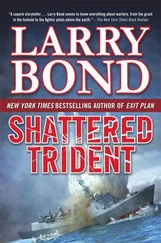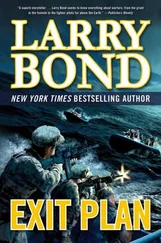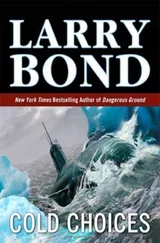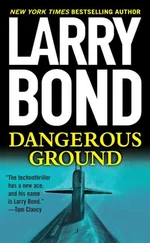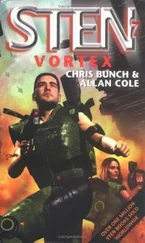“Roger, ” the aerial tanker’s boom operator responded over the intercom.
“Pumping stopped. Good luck and give them hell.” They were operating under conditions of strict radio silence, but the boom connecting them to the KC-10 also allowed them to talk to the tanker directly.
“Released.”
The refueling boom snapped up and away from the Starlifter in a white puff of jet-fuel vapor.
The colonel eased back very gently on the throttles, watching carefully as the huge tanker pulled farther out in front. Satisfied that he now had enough room to avoid a midair collision, the colonel banked the MC-141 gently to the right and slid back into place at the head of his formation.
Sierra One Zero’s pilot watched the tankers slide past his side window and disappear from sight. Then he pushed his throttles forward again, listening as the roar from Starlifter’s four engines grew louder. An indicator showed the plane picking up airspeed, accelerating from the 330 knots used for in-flight refueling toward its normal cruising speed of 550 knots.
The five jet transports carrying the 1/75th now flew in a tight arrowhead, with one Special Operations MC-141 out in front and four standard
Starlifters behind and to either side. The 2/75this C-141s, anotherMC-141, and more tankers were several miles behind the formation.
“The MC-141s, designed for long-range penetration missions deep in enemy territory, carried just about every piece of special electronic gear known to man-terrain-following radar for low-level flight, infrared TV, and jamming systems to boggle hostile radars if they were detected.
With luck, they’d be able to lead the less capable C-141s all the way in to
Pretoria.
The SAC tankers altered course and began pulling away fast, heading back for their own refueling stop at Ascension Island nearly sixteen hundred miles to the west.
He toggled his intercom switch.
“Bob?”
“Yes, Colonel?” Lt. Col. Robert O’Connell answered immediately from his position in the crowded troop compartment below and behind the cockpit. His regimental commander, Colonel Gener, was in Sierra One Three-flying in a separate aircraft to make sure that no single crash or mishap would leave the 1/75th leaderless.
“We’re gassed up and heading in. Estimate we’ll cross the coast in twenty minutes. “
The Air Force colonel could hear the tension in the Ranger battalion commander’s voice.
“Thanks, I’ll pass the word.”
The five C-141s continued east, flying high above an unbroken layer of cloud and beneath a sky full of bright, un winking stars.
ABOARD USS CARL VINSON, IN THE INDIAN OCEAN
Rear Adm. Andrew Douglas Stewart stood watching from the Vinson’s bridge as her four steam catapults threw plane after plane into the night air.
F-14 Tomcats, A-6 Intruders, F/A-18 Hornets, and EA-613 Prowlers screamed aloft, tailpipes glowing orange in the darkness. Others, engines idling, waited their turn to taxi onto the catapults. Navigation lights blinked in the sky, aircraft orbiting slowly around the task force while waiting for the whole strike to form up.
“Admiral?”
Stewart turned toward a waiting lieutenant.
“Yes.”
“Washington’s on the secure phone, sir.”
Stewart brushed past him into the darkened enclosed bridge. Enlisted men and officers alike bent over their work, with only the nearest ones acknowledging his presence with deferential nods. He moved immediately to the red secure phone and took the handset from his portly communications officer.
“Stewart here.”
There was no apparent delay, even though a computer scrambled his words, converted them into a radio signal, beamed them twenty-four thousand miles straight up to a satellite in geosynchronous orbit, and then down to the Pentagon. Then the process was repeated in reverse and Gen. Walter
Hickman’s gentle Oklahoma twang sounded in his ear. The chairman of the
Joint Chiefs was brief and to the point.
“Sierra Force has reached Point
Yankee. Execute Phase Two.”
Stewart was equally brief.
“Acknowledged. Out.” He replaced the red phone.
His imagination reached out toward Sierra Force-the C-141s carrying the
Rangers and their attached Army Aviation units. Point Yankee was a computer-designated spot over the barren Kalahari Desert where the Air Force transports would begin a planned steep descent out of the now-normal African-airspace traffic pattern of Soviet cargo planes and civilian airliners. At less than five hundred feet, well below the coverage of South Africa’s remaining ground radar stations, the C-141s would turn sharply southeast toward Pretoria and the Pelindaba Nuclear Research Complex.
The admiral picked up a plain black ship’s phone.
“CAG? This is Stewart.
Execute Pindown.” Through the receiver, he heard the Vinson’s air wing commander relaying his order to the strike leader already orbiting overhead.
They were committed.
NOVEMBER 29-ABOARD SIERRA ONE ZERO, NORTH OF RUSTENBURG, SOUTH AFRICA
Sierra One Zxro’s pilot kept his eyes moving in a regular pattern-shifting from his terrain-following radar display to the flight instruments to the low hills and flat grasslands flashing past the MC14 I’s cockpit and then back again. His hands were poised on the controls, ready to take instant evasive action should it prove necessary. Sweat trickled down his forehead despite the cockpit air-conditioning. Flying the large, four-engined transport barely three hundred feet off the ground required intense concentration. A second’s inattention could all too easily prove fatal for the more than one hundred men aboard.
“Point Zulu.” His copilot looked up from the computer generated map.
“Roger.” The colonel reduced his throttle settings, hoping the four planes following close behind were paying careful heed to their spacing.
“Inform out passengers.”
Sierra One Zero’s copilot pushed a well-worn button.
A red light came on over the Starlifter’s large rear door.
Lt. Col. Robert O’Connell was already rising from his seat
as the plane’s jumpmaster bellowed, “Six minutes! Outboard personnel hook up!”
Rangers seated along the C-141’s fuselage clambered to their feet.
“Inboard personnel stand up!”
The troops seated in two rows facing outward scrambled upright.
“Hook up!”
The Rangers hooked their parachute harnesses on to the static lines running the length of the MC-141’s troop compartment. A very pate Prof.
Esher Levi imitated them.
Outside the compartment, the droning roar of the Starlifter’s engines began fading as the big plane slowed to jump speed.
HEADQUARTERS, NORTHERN AIR DEFENSE SECTOR, DEVON, EAST OF
JOHANNESBURG
The South African Air Force flight sergeant yawned once, and then again, wishing he could slip outside for a quick cup of coffee and a smoke. Night radar-watch duty was invariably boring. Lately, neither the Cubans nor his own air force had shown much willingness to risk precious aircraft in combat operations after dark. Both sides had already lost too many planes in raids against strategic and tactical targets.
He leaned forward to study the glowing screen again, his face green in the light emanating from the radar repeater. He didn’t see anything out of the ordinary. Just blips at the far edge of his coverage showing a steady stream of Soviet air transports and cargo planes ferrying men and materiel into Zimbabwe and Mozambique. A smaller number of blips closer in represented South African transports moving units out of Namibia.
The sergeant shrugged, deciding that he was lucky to be able to see that much. South Africa’s radar net, already inadequate before the war, was in even worse shape now. Mafikeng, the site of one of its three permanent stations, had already been overrun by the Cubans. And Ellisras, the northernmost station, was expected to fall any day now.
Читать дальше



